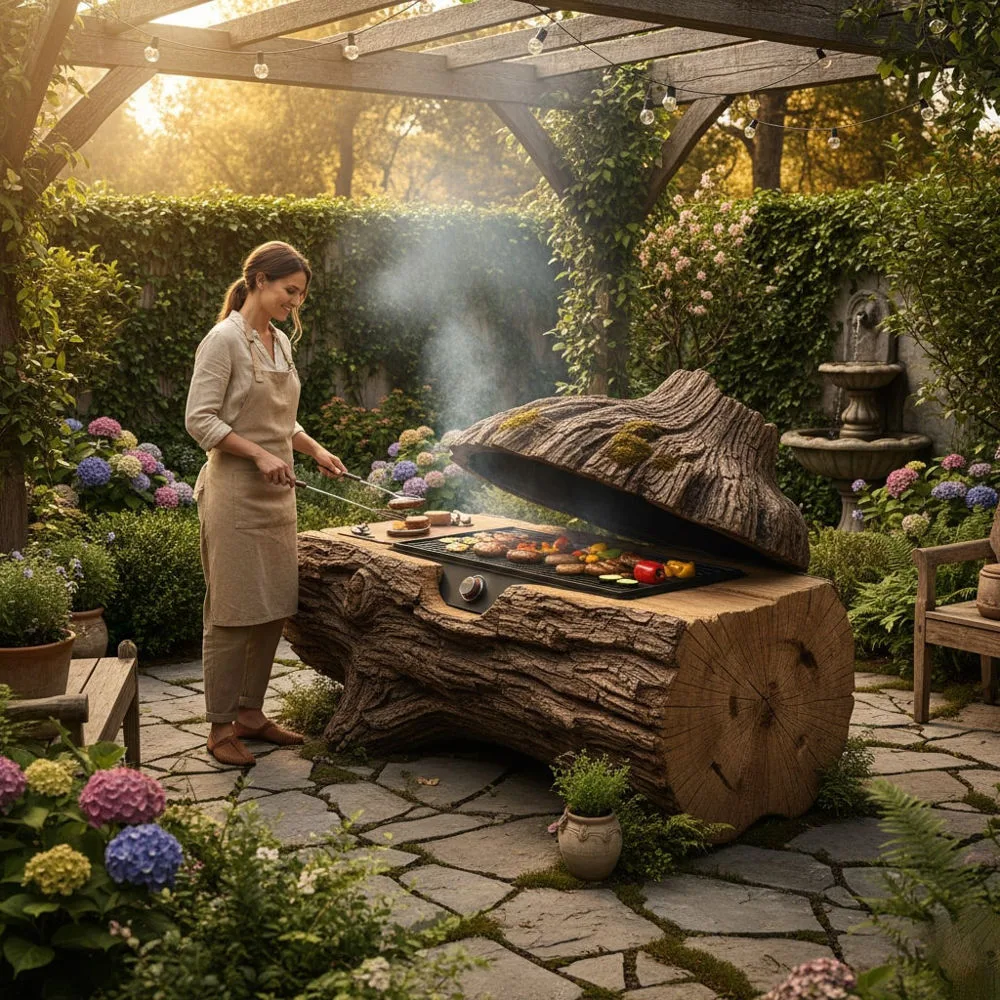What Are Tree Stump BBQ Grills and Why They’re Taking Backyards by Storm
Tree stump BBQ grills represent one of the most innovative and environmentally conscious approaches to outdoor cooking that has captured the imagination of barbecue enthusiasts worldwide. These remarkable cooking stations transform what would otherwise be yard waste into functional, beautiful, and conversation starting grilling platforms that seamlessly blend with natural landscapes.
Unlike traditional metal grills that can look out of place in garden settings, tree stump BBQ grills offer an organic aesthetic that complements any outdoor space while providing exceptional cooking performance. The concept involves hollowing out a substantial tree stump and converting it into a fully functional grilling station, complete with proper ventilation, cooking surfaces, and safety features.
The growing popularity of these natural grilling solutions stems from their unique combination of sustainability, functionality, and visual appeal. Homeowners are increasingly seeking ways to reduce their environmental footprint while creating distinctive outdoor living spaces, and tree stump BBQ grills perfectly address both objectives.
The Art of Selecting the Perfect Tree Stump for Your BBQ Project
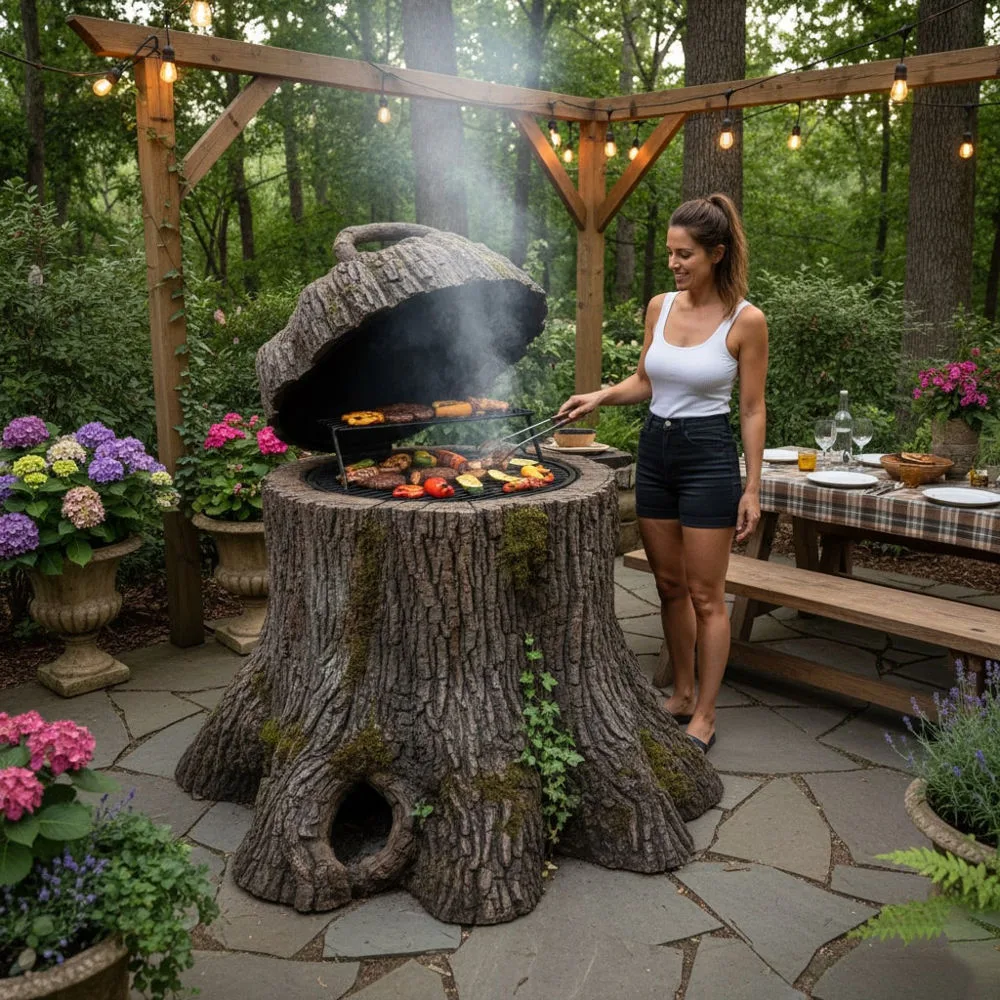
Creating successful tree stump BBQ grills begins with choosing the right foundation. The ideal stump should measure at least 24 inches in diameter and stand 18 to 24 inches above ground level. This size provides adequate internal space for proper heat circulation while maintaining structural integrity throughout the construction process.
Hardwood stumps from oak, maple, hickory, or cherry trees work exceptionally well due to their density and resistance to rapid burning. These woods also impart subtle flavoring to grilled foods, enhancing the overall cooking experience. Avoid softwood stumps from pine or fir trees, as they burn too quickly and may produce undesirable flavors or excessive smoke.
The stump should be well seasoned, ideally having been cut and dried for at least six months to a year. Fresh stumps contain excessive moisture that can create steam pockets and unpredictable burning patterns. Inspect potential stumps for signs of rot, insect damage, or structural weakness that could compromise the finished grill’s safety and longevity.
Consider the stump’s location carefully, ensuring adequate clearance from structures, overhanging branches, and combustible materials. The area should be level and provide easy access for cooking and maintenance activities while complying with local fire safety regulations.
Essential Tools and Materials for Building Tree Stump BBQ Grills

Constructing tree stump BBQ grills requires specific tools and materials to ensure both safety and functionality. A chainsaw serves as the primary tool for hollowing out the stump’s interior, while various hand tools help refine the work and add finishing touches.
Safety equipment takes priority in any tree stump BBQ project. Heavy duty work gloves, safety glasses, hearing protection, and chainsaw chaps protect against injury during construction. A dust mask prevents inhalation of wood particles and debris that accumulate during the hollowing process.
For the interior lining, fire bricks or heat resistant stones create a barrier between the burning wood and the stump walls. These materials help regulate temperature, protect the stump from excessive heat damage, and improve overall cooking performance. High temperature mortar secures the brick lining and fills any gaps that could allow heat to escape.
The cooking surface requires a heavy gauge steel grate sized to fit the interior dimensions of your hollowed stump. Stainless steel grates resist corrosion and maintain their structural integrity under high heat conditions. Some builders prefer cast iron grates for their superior heat retention and distribution properties.
Ventilation components include metal pipes or fittings for air intake holes and chimney construction. Proper airflow management ensures complete combustion, reduces smoke production, and maintains consistent cooking temperatures throughout grilling sessions.
Step by Step Construction Process for Your Tree Stump Grill
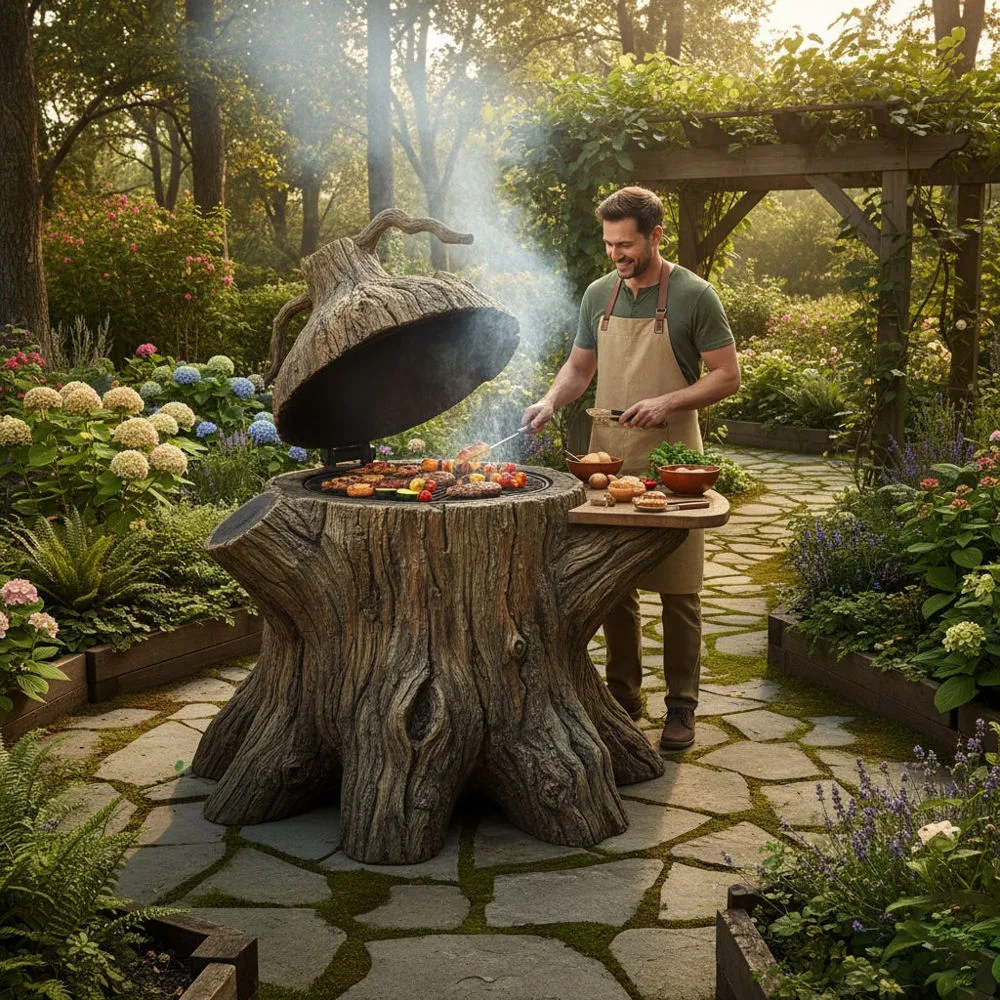
The construction of tree stump BBQ grills follows a methodical process that requires patience, precision, and attention to safety details. Begin by marking the interior cavity dimensions on the stump’s top surface, leaving approximately 4 to 6 inches of wall thickness around the perimeter for structural integrity.
Using a chainsaw, carefully remove wood from the interior cavity in manageable sections. Work slowly and maintain control of the saw at all times, as the confined space can make maneuvering challenging. Remove wood in horizontal layers rather than attempting to cut straight down, which helps maintain better control and prevents binding.
Create the primary air intake by drilling or cutting a hole approximately 2 inches in diameter near the base of the stump. This opening should be positioned to catch prevailing winds while remaining protected from rain and debris. The intake hole connects to the interior cavity through a channel that may require additional excavation.
Install the fire brick lining by applying high temperature mortar to the cavity walls and carefully positioning each brick. Ensure tight joints between bricks to prevent heat leakage and maintain structural integrity. Allow the mortar to cure according to manufacturer specifications before proceeding with additional construction steps.
Design and install a chimney system that provides adequate draft for proper combustion. The chimney can be integrated into the stump itself or added as an external component using metal piping. Position the chimney outlet to direct smoke away from the cooking area and neighboring properties.
Safety Considerations and Best Practices for Tree Stump Grilling
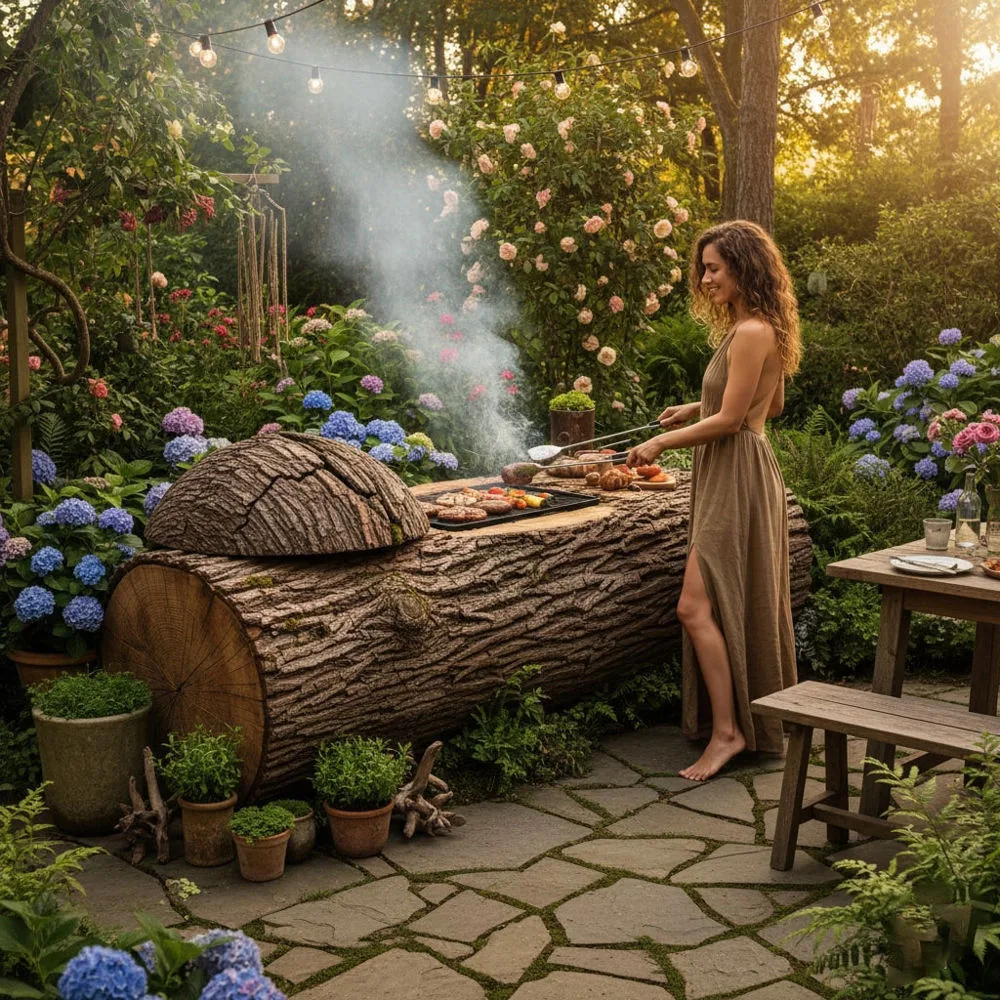
Safety remains paramount when operating tree stump BBQ grills, as these units involve open flames, high temperatures, and combustible materials. Understanding and implementing proper safety protocols protects both users and property while ensuring years of safe grilling enjoyment.
Never leave a tree stump grill unattended while burning, and maintain a fire extinguisher or water source nearby for emergency situations. The organic nature of the stump means that excessive heat or improper use could potentially ignite the wood structure itself, creating dangerous conditions.
Monitor internal temperatures carefully to prevent overheating that could damage the stump or create safety hazards. Most tree stump BBQ grills operate most effectively at temperatures between 400 and 600 degrees Fahrenheit for standard grilling applications. Higher temperatures may be suitable for searing but require additional caution and monitoring.
Clear the area around your tree stump grill of flammable materials including dry leaves, paper, lighter fluid containers, and wooden furniture. Maintain at least a 10 foot clearance radius from any structures or overhanging vegetation that could catch fire from sparks or radiant heat.
Establish a routine inspection schedule to check for structural deterioration, loose fire bricks, or other potential safety issues. Address any problems immediately to prevent accidents or further damage to the grilling system.
Maintenance Tips to Keep Your Tree Stump BBQ in Peak Condition
Proper maintenance ensures that tree stump BBQ grills continue operating safely and effectively for many seasons. Regular cleaning removes ash, grease, and food residues that can create fire hazards or affect cooking performance. Allow the grill to cool completely before beginning any maintenance activities.
Remove cooking grates and clean them thoroughly with appropriate brushes and cleaning solutions. Stainless steel grates benefit from specialized cleaners that remove stubborn grease and carbonized food particles. Cast iron grates require seasoning after cleaning to maintain their non stick properties and prevent rust formation.
Inspect the fire brick lining periodically for cracks, loose mortar, or displaced bricks that could compromise the grill’s efficiency or safety. Replace damaged bricks promptly and repoint mortar joints as needed to maintain the protective barrier between flames and wood.
Clean the interior cavity by removing accumulated ash and debris that can restrict airflow and reduce combustion efficiency. Use a shop vacuum or specialized ash vacuum designed for fireplace cleaning to remove fine particles safely. Check air intake and chimney passages for obstructions that could affect ventilation.
Apply appropriate wood treatments to exposed exterior surfaces to protect against weather damage and extend the stump’s lifespan. Avoid treatments near areas that will be exposed to high heat, as many wood preservatives can produce toxic fumes when heated.
Creative Design Ideas and Customization Options
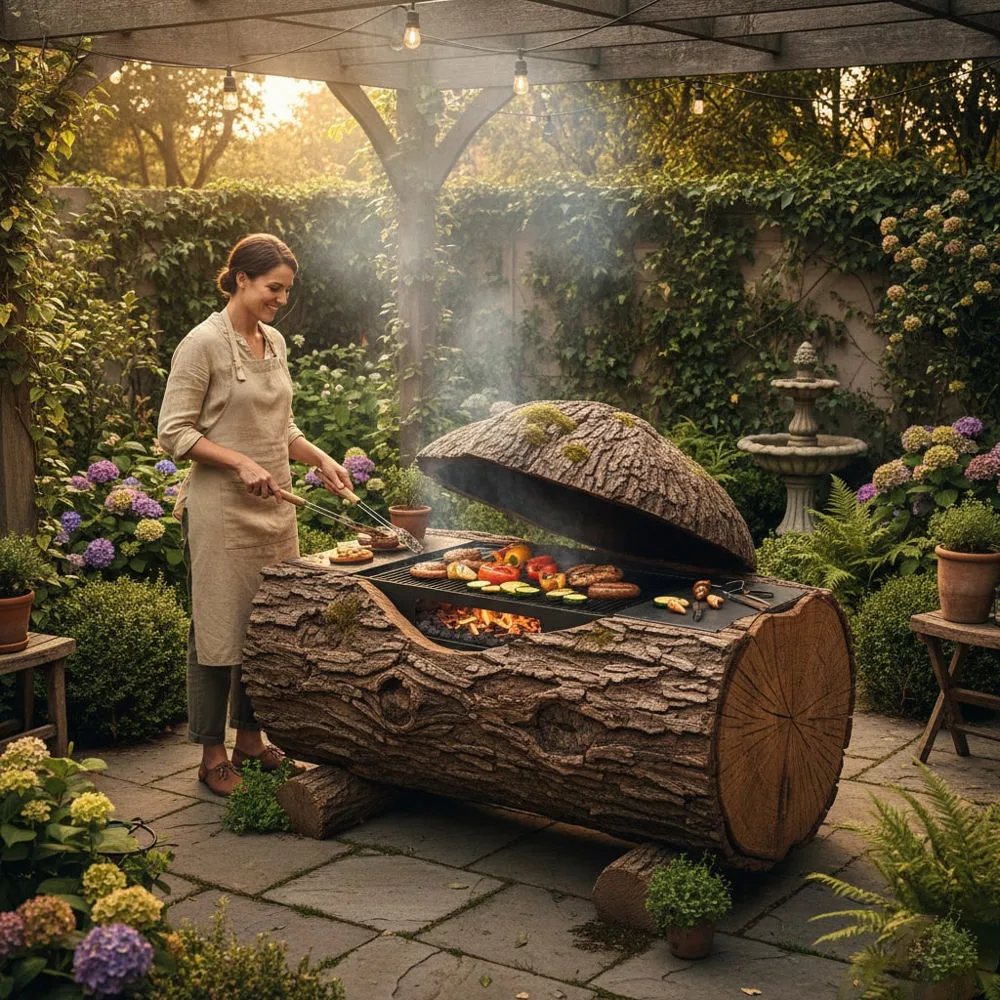
Tree stump BBQ grills offer unlimited opportunities for personalization and creative expression that reflect individual tastes and outdoor living styles. The natural canvas of wood accepts various decorative treatments, functional additions, and aesthetic enhancements that transform basic cooking stations into stunning outdoor focal points.
Consider incorporating stone or brick work around the base of your tree stump grill to create an integrated cooking area that includes prep surfaces, storage spaces, and seating areas. These additions enhance functionality while creating a cohesive outdoor kitchen environment that feels intentionally designed rather than improvised.
Decorative metal work adds both visual interest and functional elements to tree stump BBQ grills. Custom forged handles, decorative air vents, and artistic chimney caps showcase craftsmanship while improving the grill’s usability and weather resistance.
Some builders incorporate multiple cooking levels within their tree stump grills, creating zones for different cooking methods such as direct grilling, indirect cooking, and smoking. This approach maximizes the cooking potential of the available interior space while accommodating various culinary techniques.
Lighting systems extend the usability of tree stump grilling areas into evening hours while creating dramatic visual effects. Solar powered LED strips, battery operated spotlights, or low voltage landscape lighting can illuminate the cooking area safely without requiring complex electrical installations.
Cooking Techniques and Recipe Ideas for Tree Stump Grills
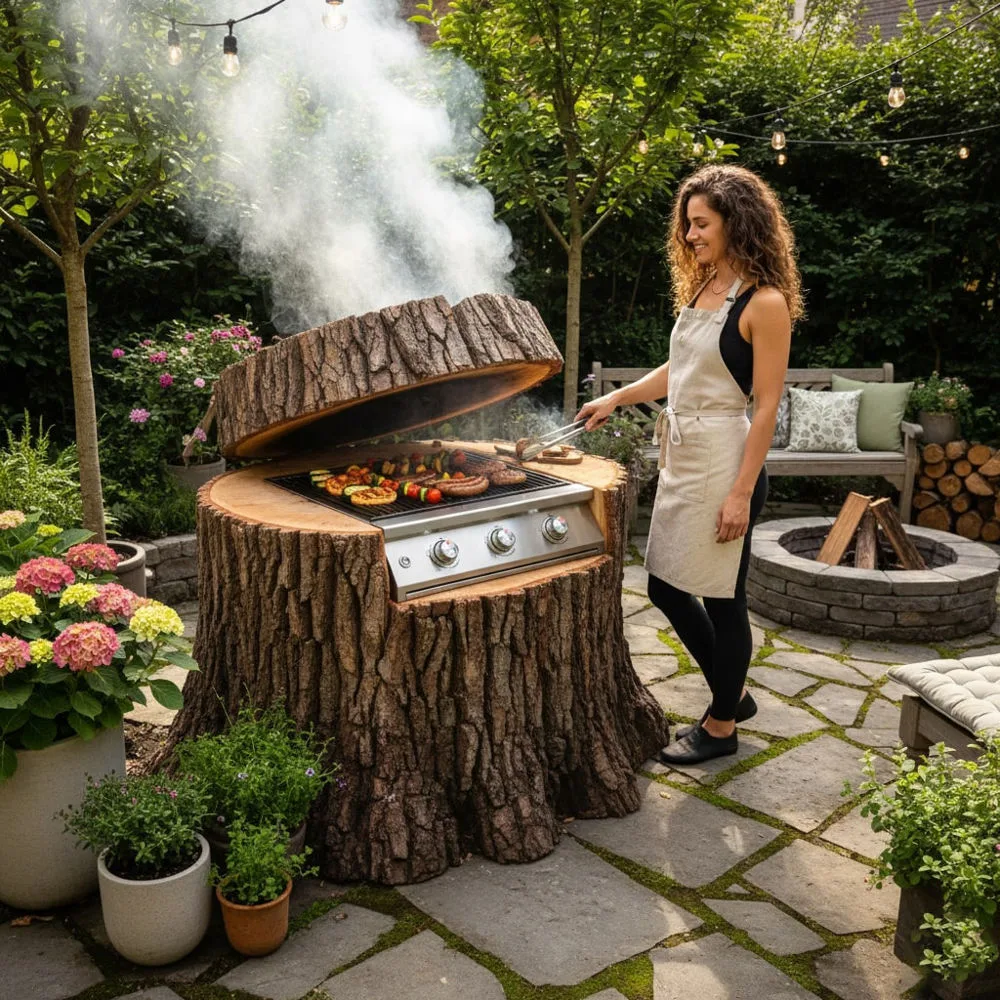
Tree stump BBQ grills excel at traditional grilling techniques while offering unique opportunities for creative cooking approaches that take advantage of their wood burning capabilities. The combination of radiant heat from the fire bricks and convective heat from the burning wood creates ideal conditions for achieving restaurant quality results in backyard settings.
Direct grilling over hot coals produces exceptional steaks, chops, and vegetables with distinctive smoky flavors that cannot be replicated with gas grills. The high heat output of well designed tree stump grills creates perfect searing conditions that lock in juices while developing attractive grill marks and caramelized surfaces.
Indirect cooking techniques work particularly well in tree stump grills due to their thermal mass and heat retention properties. Slow roasting whole chickens, pork shoulders, or beef roasts produces incredibly tender and flavorful results while the wood smoke penetrates deep into the meat.
Smoking applications represent one of the most exciting aspects of tree stump BBQ cooking. By managing airflow and fuel selection, these grills can maintain the low, steady temperatures required for authentic barbecue smoking while imparting complex flavors from different wood types.
Pizza cooking becomes possible with the addition of specialized stones or steel surfaces that can withstand the high temperatures achievable in properly designed tree stump grills. The wood fired environment creates authentic Neapolitan style pizzas with perfectly charred crusts and beautifully melted toppings.
Environmental Benefits and Sustainable Grilling Practices
Tree stump BBQ grills represent an excellent example of upcycling and sustainable living practices that reduce waste while creating functional outdoor equipment. Rather than paying for stump grinding services or allowing stumps to decay naturally over many years, conversion to grilling stations provides immediate utility while addressing landscape maintenance needs.
The use of fallen branches, pruning waste, and other yard debris as fuel creates a closed loop system that minimizes external inputs while managing organic waste effectively. This approach reduces dependence on manufactured charcoal or propane while utilizing materials that would otherwise require disposal.
Wood burning grills produce lower overall environmental impacts compared to propane units when fuel sourcing and transportation factors are considered. Local wood sources eliminate shipping impacts while supporting regional forest management practices that maintain healthy woodland ecosystems.
Carbon sequestration continues even after tree stumps are converted to grills, as the remaining wood structure stores carbon that would otherwise be released through natural decomposition processes. This benefit extends the environmental value of trees beyond their natural lifespans.
Common Challenges and Troubleshooting Solutions
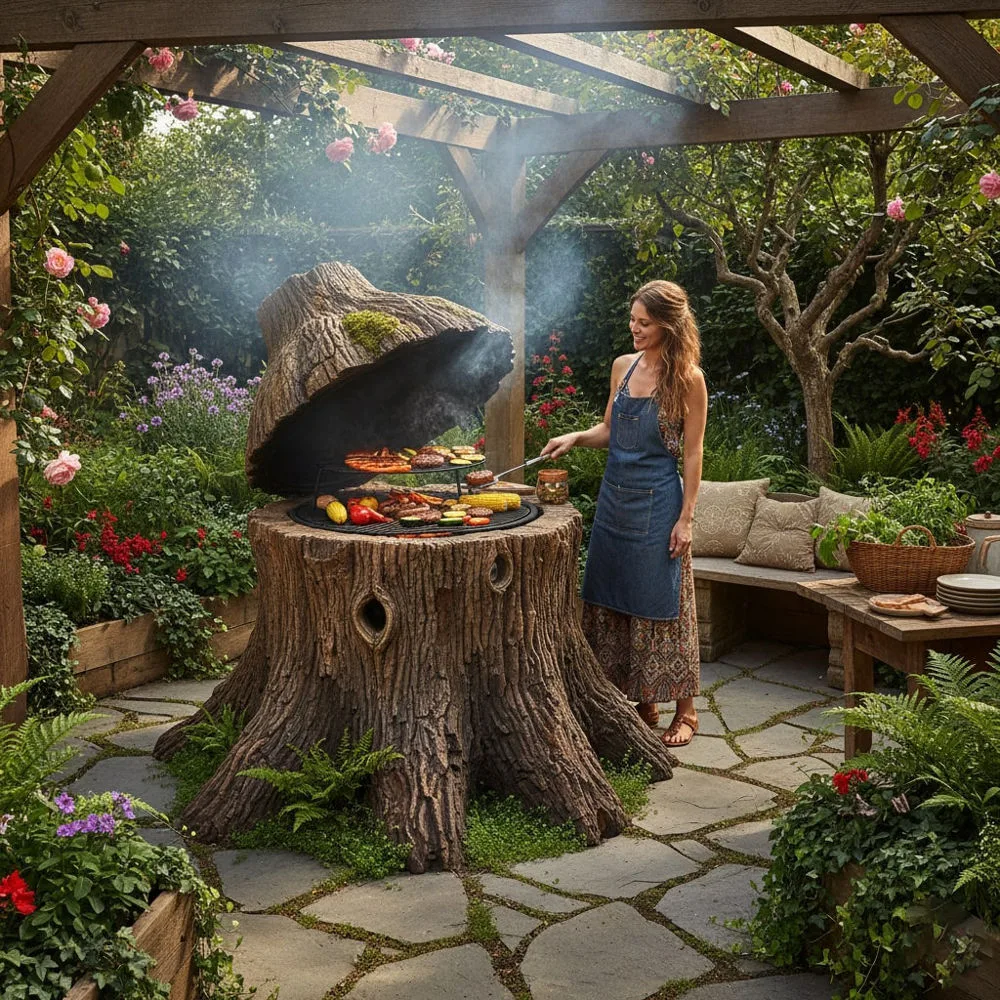
Building and operating tree stump BBQ grills presents unique challenges that require specific knowledge and problem solving approaches. Understanding common issues and their solutions helps ensure successful projects and ongoing operational satisfaction.
Inadequate draft represents one of the most frequent problems with tree stump grills, resulting in poor combustion, excessive smoke, and difficulty maintaining consistent temperatures. This issue typically stems from insufficient air intake, blocked ventilation passages, or improperly designed chimney systems. Solutions include enlarging air intake openings, clearing obstructions, or modifying chimney height and positioning.
Structural deterioration of the stump itself can occur when heat protection measures are inadequate or when the wood was not properly seasoned before construction. Prevention involves using appropriate fire brick lining, maintaining proper clearances, and monitoring operating temperatures carefully.
Temperature control challenges often arise from inexperience with wood burning cooking methods or inadequate ventilation design. Learning proper fuel management techniques and understanding how airflow adjustments affect temperature helps overcome these difficulties.
Water damage from rain or snow can affect both the structural integrity of the stump and the performance of internal components. Protective covers, drainage systems, and appropriate material selection help minimize weather related problems.
Investment Considerations and Cost Analysis
The financial investment required for tree stump BBQ grills varies significantly depending on the scope of the project, material choices, and whether construction is undertaken as a DIY project or contracted to professionals. Understanding these cost factors helps determine the feasibility and value proposition of different approaches.
DIY construction typically costs between $200 and $800 for materials, assuming the stump is already available on the property. This includes fire bricks, mortar, metal components, tools, and safety equipment. Labor intensive aspects of the project require significant time investments but eliminate contractor costs.
Professional construction services may charge $1,500 to $4,000 depending on design complexity, local labor rates, and material specifications. This option ensures proper construction techniques and may include warranties or service guarantees that protect the investment.
Long term value considerations include reduced fuel costs compared to propane grills, elimination of stump removal expenses, and the unique aesthetic appeal that can enhance property values. The durability of well constructed tree stump grills often exceeds that of manufactured alternatives, providing years of reliable service.
Maintenance costs remain relatively low, primarily involving replacement of fire bricks, grates, and occasional wood treatment applications. These expenses are typically less than the ongoing fuel and maintenance costs associated with conventional grilling equipment.
Conclusion: Embracing the Natural Art of Tree Stump Grilling
Tree stump BBQ grills represent far more than simply a unique cooking method; they embody a philosophy of sustainable living, creative problem solving, and connection with natural materials that has been largely lost in our modern world. These remarkable cooking stations transform what many consider waste into functional art pieces that serve families and friends for generations while respecting environmental principles.
The journey of creating and using tree stump BBQ grills offers rewards that extend beyond the exceptional flavors they produce. The construction process itself provides opportunities for learning new skills, working with natural materials, and creating something truly unique that reflects personal creativity and craftsmanship values.
From both practical and philosophical perspectives, tree stump grilling addresses many of the concerns that thoughtful consumers have about modern outdoor cooking equipment. Issues such as sustainability, authenticity, functionality, and aesthetic integration find resolution in these natural grilling solutions that prove innovation often comes from looking backward to traditional approaches rather than always seeking technological complexity.
The growing community of tree stump grill enthusiasts demonstrates that this approach appeals to diverse individuals who share common values of environmental stewardship, culinary excellence, and creative expression. Whether motivated by sustainability concerns, desire for unique outdoor features, or passion for exceptional grilling results, builders consistently report satisfaction with their decision to embrace this natural cooking method.
As more people discover the benefits and pleasures of tree stump BBQ grills, this sustainable approach to outdoor cooking will undoubtedly continue evolving and inspiring new generations of environmentally conscious grill masters who understand that the best solutions often come from working with nature rather than against it.

